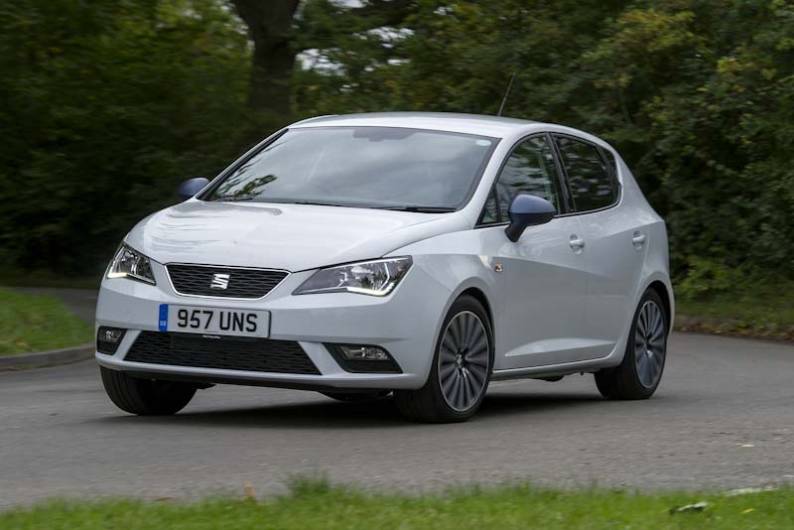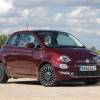
RAC sale – up to 33% off*
• Roadside cover from £5.29 a month†
• We get to most breakdowns in 60 mins or less
• Our patrols fix 4/5 breakdowns on the spot

By Jonathan Crouch
Introduction
SEAT launched the fourth generation version of its Ibiza supermini, but subsequently never stopped trying to improve it. The final set of revisions arrived in 2015 to carry this design through the final couple of years of its life. It's these 2015 to 2017-era models that we evaluate here as a used car buy.
Models
3/5dr hatch. 5dr estate (1.0, 1.2, 1.4 petrol, 1.4 TDI diesel [E, S A/C, SE, FR, Cupra, Toca])
History
The 'Sociedad Espanola de Automoviles de Turismo' - or 'SEAT' as we better know it - is well used to injecting a little life into the mainstream market. Its 600 model, launched in 1957, is the fun little runabout credited with putting Spain on wheels, over a million being sold to bronzed Iberians in just eleven years. Only when Volkswagen took control of the brand in 1986 though, did its appeal start to spread to the rest of Europe, with the Ibiza supermini the sales spearhead and this MK4 model, launched in 2008, generally acknowledged as the company's most competitive proposition yet.
A few years on though and with toughening small car competition, it was clear that a bit of a re-think might be needed to keep this car current. We got a refresh in 2012, then a more far-reaching update announced in the Autumn of 2015 - the one we evaluate here. This later package of changes brought an all-new 1.0-litre EcoTSI petrol engine and revised, more compliant suspension. SEAT reckoned though, that what buyers would really notice were the extra personalisation options, the smarter interior and the additional media connectivity. It was all just enough to carry this MK4 design through the final couple of years of its life. An all-new MK5 model made its debut in the early Summer of 2017.
What You Get
Whichever Ibiza bodystyle you choose for this 2015 to 2017-era Ibiza - the three-door SC, the more conventional five-door hatch or the ST estate - it won't at first glance appear to have changed very much over earlier versions of this MK4 model. But then few changes were needed. Short overhangs, subtle body creases and smart, angular headlamps still make this one of the smarter superminis in the segment from this period. The original distinctive 'arrowhead' shape was penned by stylist Luc Donckerwolke (the same guy who did the Lamborghini Gallardo supercar) and by 2015, it had matured nicely, changes being limited to subtle differences. If you've owned an original fourth generation Ibiza model before, seeing this post-2015-era version will be a bit like meeting an old friend who's had the odd nip and tuck on the sly.
In terms of being more specific, well you really do have to know what to look for. Apart from a more stylish range of alloy wheels, the only really obvious exterior change with this updated post-2015-era model lies with the addition of LED daytime running light strips within the headlight clusters - and you only get them if you avoid the least expensive trim levels. Otherwise, SEAT felt that there wasn't much point in further changing the front end, given that it had been previously updated in 2012 with a narrower, sharper trapezoidal grille that aimed to add a bit of visual width and purpose to the overall shape. This sits above a sharply-contoured bumper with angular creases intended to naturally draw the eye down the car's flanks.
At the rear, the key post-2015-era change related to lighting. Where LED technology features at the front, the rear clusters also feature it, creating a more distinctive night time signature. Otherwise, the look is as smart and clean as it was in previous MK4 Ibiza models, especially with the sportier-looking bumper and more potent-looking twin tailpipes that you get with the FR versions.
View any Ibiza in profile and the main thing you'll notice will be something you'll probably either like or hate - the curious side slashes. One starts at the front wing, then falls to the middle of the rear door, while the other begins just ahead of the front door handle, then flows back towards the rear light cluster. It's a styling theme that looks great with the SC three-door bodyshape, but is more of an acquired taste when translated to five-door variants. Another design feature these more practical Ibiza models borrowed from the coupe SC version is the relatively low rakish roofline. You've got 22mm less roof height here than you'd have with, say, a Skoda Fabia and that makes all the difference when it comes to visually distancing this SEAT from some of its boxily boring rivals.
You'd think that rear seat folk might have to pay for that and for sure, with the three-door 'SC' bodystyle, there's something of an issue with restricted rear headroom. You won't be struggling quite as much in that regard if you go for a five-door bodystyle but the reality is that you will still be getting a bit less headroom than is usual for cars from this class. Fortunately for SEAT, typical Ibiza buyers are people with young families, so that never proved to be much of a sales impediment: up to three kids will be quite comfortable back here. For us, slightly more of an issue is the rather over-high central transmission tunnel you'd think you wouldn't need on a front wheel drive supermini. It's one of the things that'll make it very difficult indeed to transport three adults for any distance in this car, though if you do have to do that, it will at least help that kneeroom is reasonable by class standards thanks to the recessed seatbacks.
Taking a seat up-front brings you to the part of this car into which most of the design budget was poured when it came to this post-2015-era facelifted model's package of changes. That was a wise choice on SEAT's part. There was never very much wrong with the way that the outside of this Ibiza looked, but earlier versions always felt dull, cheap and plasticky once you got behind the wheel. This one was much nicer thanks to many elements borrowed from its larger Leon family hatchback stablemate, including a smarter dash and upgraded upholstery.
One of the most visible changes is the redesigned instrument cluster you view through the smart three-spoke multi-function steering wheel. Get comfortable in front of it - easy thanks to reach and rake-adjustment and a height-adjustable seat - and you view two clear dials with sporty-looking white numbering. The main gauges are separated by a black and white digital information display that duplicates the carousel-style graphics and much of the functionality of the infotainment screen that dominates the centre of the dash.
In its standard 5-inch form, this display was offered in either black and white or colour guise, depending on the trim level chosen. As standard or as an option, plusher Ibiza derivatives got a larger 6.5-inch colour 'Media System Plus' screen, which included a Navigation system with voice control and came with a proximity sensor so that it could sense your finger coming towards it. Whatever screen set-up original owners favoured, SEAT reckoned they'd want to use the display to duplicate the functionality of smartphone handsets and view selected apps. That's possible if you get a variant equipped with what the brand called its 'Full Link' set-up, there to work through the 'MirrorLink', 'Android Auto' and 'Apple CarPlay' systems. Android users have the added advantage of being able to download two useful apps - the 'SEAT ConnectApp' for stationary use and the 'SEAT DriveApp' for when you're on the move. With these, you can do things like display personalised information from your Facebook account, get text-to-speak messaging that'll read out current Twitter or Facebook posts, view weather forecasts and even activate functionality through a range of individual gestures.
So the Ibiza at-the-wheel experience is more media-savvy in the case of this post-2015-era model. Moving to practicalities, well there's most of what you'd expect. The door pockets are pretty small, but you get a decently-sized 10.7-litre glovebox, while further small compartments are provided lower down the fascia by your right knee and to the right of the pedal box. A small storage area at the bottom of the centre stack gives you USB, aux-in and 12v socket attachments and this sits ahead of two cupholders, with a third provided behind the (thankfully conventional) handbrake.
As for luggage space, well press in the large SEAT logo that doubles as a boot release and the rear hatch of the five-door variant opens to reveal 292-litres of cargo room, marginally more than the 284-litre total offered by the sportier three-door SC bodystyle. True, that's nothing like as much capacity as you'd find in boxier superminis from this segment like Skoda's Fabia or Hyundai's i20, but it's pretty comparable to what you'd get from direct rivals like Ford Fiesta, Vauxhall Corsa and Peugeot 208 models from this era. If you do want more space, going for an Ibiza in ST estate guise will increase your boot capacity to 430-litres. As for practicalities in the boot area, well there's a bag hook - but no useful 12v socket or tie-down points to keep awkward items in place. You do get extra underfloor storage, but only if the model in question doesn't have a space-saver spare wheel.
If you need more room, then of course you can as usual push forward the rear bench. It'll be split-folding provided you've avoided entry-level trim but it doesn't fall quite flat. Once retracted, up to 847-litres of space is revealed for both the three and five-door hatch bodystyles - or up to 1,164-litres if you've gone or the ST estate. That latter figure is 231-litres less than you'd get from a comparable but more boxy Skoda Fabia estate, but it's still enough to allow an owner to carry two bicycles with the front wheels removed.
What You Pay
Please fill in the form here for an exact up-to-date information.
What to Look For
We came across quite a few very satisfied Ibiza owners but inevitably, there were a number of issues. SEAT has a reputation for thin paintwork, so look out for stone chips on the body. Other issues we came across in the survey included a broken coil spring, a leaker rear window washer, ignition coil pack failure, an instance of intercooling pipework joints failing and the front foglamps misting up. One owner reckoned he was having to replace the rubber suspension bushes at the front every 18 months too.
Corrosion is simply not an issue with SEATs and another reason why resale values are high. The alloy wheels on the Cupra models are very prone to kerb rash and look for crash damage and tired tyres. Check that the electronic systems work as advertised as there have been a few minor owner grumbles about warning lights spuriously appearing and then disappearing. There are quite a few 'Cat C' and 'Cat D' repaired write-offs at the lower end of the market, so if you see an Ibiza that looks too good to be true, chances are it's had a prang.
Replacement Parts
(approx based on a 2016 Ibiza 1.2 TSI) An air filter costs around £15 and an oil filter costs around £6. Brake pads sit in the £26 to £35 bracket for a set, though you could pay up to around £50 to £55 or even as much as £80 for a pricier brand. Brake discs costs between £21 to £50 for a pair, though you could pay as much as £80 or even just over £100 for a pair of discs from a pricier brand. A pair of wiper blades cost in the £6 to £12 bracket, though you could pay up to around £30 for pricier brands. A radiator will sit in the £85 to £95 bracket. Try not to damage the headlamp; a replacement unit costs around £150. A rear lamp is around £45.
On the Road
What is it about this car? It ought to drive just like a comparable Volkswagen Polo or Skoda Fabia. The underpinnings, after all, are very similar. Yet somehow, it doesn't. Perhaps the sportier styling and more dynamic brand image that this SEAT has lead you to push it that little bit harder, revealing unexpected handling talent that a Fabia or a Polo could also offer - if only given the chance. Maybe. But somehow we doubt it.
SEAT largely managed to maintain this eagerness with this post-2015 further improved fourth generation model, despite the adoption of softer springs and dampers that enabled the car to do a better job than before when it came to absorbing the imperfections of our road network's terrible tarmac. That was one key change with this revised model. The other lies with the provision for petrol buyers of the downsized 1.0-litre three cylinder powerplant that by 2015, we had already seen in other Volkswagen Group models. This was the first time that this unit had been offered in all three of its main guises.
Buyers of entry-level Ibiza models got this 1.0-litre engine in entry-level 75PS normally aspirated form, where it's willing enough but ultimately limited by a mere 95Nm of torque, which means that 62mph takes 14.3s en route to 107mph. It's much better, if you can shake the piggy bank a little more, to stretch to this powerplant in 'EcoTSI' turbocharged guise, where it not only offers extra performance but much improved efficiency too. We think the sweet spot in the range is delivered by the 95PS 1.0 EcoTSI model. This makes 62mph in 10.4s en route to 119mph, picks up smoothly from around 1,500rpm and manages to offer an endearing growl towards the top of the rev range while at a cruise, maintaining decent standards of refinement. This engine also came in 110PS guise mated to DSG automatic transmission, in which form 62mph is 9.3s away en route to 122mph.
Both of the1.0-litre EcoTSI powerplants feel revier and more satisfying to use than the 90 and 110PS 1.2-litre TSI petrol units they effectively replaced, though at the launch of this improved Ibiza line-up in 2015, SEAT continued to offer buyers the option of these older engines. Look further up the petrol range and you'll find the cleverest engine in the line-up, the 1.4-litre EcoTSI unit. This one has four cylinders, but under light throttle loads, only two of them ever get used, thanks to smart 'ACT' 'Active Cylinder Technology'. That allows this variant to deliver impressive near-60mpg combined cycle economy but rapid performance too, 62mph occupying just 7.6s en route to 137mph.
If that's not fast enough, then you'll need the top SC Cupra hot hatch variant. Unlike the pre-2015 Ibiza Cupra model which used a supercharged and turbocharged 1.4-litre petrol engine, this 2015 to 2017-era version provides shopping rocket buyers with a more conventional 1.8-litre TSI turbo unit. This powerplant delivers two advantages. First, it's compatible with a manual gearbox (which the old 1.4-litre unit wasn't). And second, it delivers more power - 192PS, along with a pokey 320Nm of torque, 70Nm more than the old model could manage. As a result, 62mph can now be reached by Cupra buyers in just 6.7s, en route to 146mph.
Ibiza buyers in search of diesel power get a 1.4-litre TDI unit that most will select in its entry-level 75PS form. This engine could do with a touch more refinement but there's not much wrong with the performance it offers. In its base guise, 62mph takes around 13s on the way to about 107mph, figures you can improve slightly if you opt for the 90PS version of this powerplant that comes mated to DSG auto transmission in the ST estate variant. The 1.4-litre TDI engine was also offered in 105PS guise to 'FR'-spec buyers, where it makes 62mph in 9.9s en route to 119mph. With the 'FR' package, you get more than just a more dynamic look, this trim level also including firmer sports suspension and a clever XDS electronic differential lock which will help you get the power down more quickly out of tight corners, dialing out understeer and firing you from bend to bend.
Right across the Ibiza range, the surprise is, as we said at the beginning, just how much enjoyment is on offer from this bright and lively little car. Petrol variants turn into corners a little more responsively than their more nose-heavy diesel counterparts but all derivatives handle with big car fluency. They're pretty enjoyable to punt around town too, once you get used to the rather restricted rear view out thanks to hefty rear pillars. Overall then, what we have here is a car on which you don't need to spend a fortune to have fun.
Overall
Due to its package of carefully-judged updates, this post-2015-era Ibiza doesn't really feel in any way out-dated, thanks to a Leon-style interior and a package of media connectivity that was cutting-edge in its period for the supermini sector. Sharp styling and a wide range of bodystyles also weigh in this car's favour too. As do the low running costs you can achieve if you opt for the EcoTSI and Ecomotive engines.
There are, it's true, sharper-handling rivals. And there are those that will be cheaper or better equipped. But this SEAT is there or thereabouts in all of the key areas. Plus find one smartly dressed by its original owner and it can look very sharp indeed. In summary, we're looking here at a car that matured nicely. And can make plenty of sense as a used buy.







